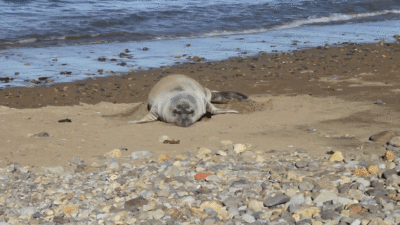
Did you know? Northern Elephant seals have one of the longest mammal migrations on the planet! They spend almost all their time venturing across the ocean, specifically in the North Pacific range, and travel from their rookery sites out to the continental shelf and back again twice in one year. This migration is done twice due to breeding and molting events, spending only about one month each time on the beach before returning back to the open ocean.
 These animals are truly amazing, possessing some pretty impressive abilities. The longest recorded dive of an elephant seal was around 2 hours, and the deepest dive was recorded to be around 5,000 feet. These silly seals get their name from the gigantic nose that is grown by males at sexual maturity. This nose, or proboscis, helps the male by allowing him to make loud trumpeting echoes and this helps attract females as well as to assert dominance over smaller males. Males usually arrive at the breeding beach, or rookery, around January to scout out a spot on the beach. Then the females arrive and will mate as well as give birth to their newborns that they have been carrying since the previous year. The females will stay on the beach nursing their newborn pup for around 28 days before heading back into the water and leaving their pups to fend for themselves. Pups will band together and slowly learn how to catch food in tide pool areas before easing their way into the open ocean. The California coastline holds some of the largest elephant seal rookeries, where they return year after year for mating, birthing, and a catastrophic molt in the summer. During this catastrophic molt, they will shed their first layer of hair and skin, which is quite the sight for an unknowing onlooker! There are many great vistas and protected areas where the public can view these glorious seals in their natural habitat, but don’t get too close! Males can weigh in at a whopping 5,000 pounds, and will charge when threatened. The most miraculous thing about these elephant seals isn’t their size, stamina, or diving abilities. They were able to bounce back from the brink of extinction, with less than 100 individuals left by 1910. They were hunted for their rich blubber, but with the proper protection, are now thriving with an estimated population of around 200,000.
These animals are truly amazing, possessing some pretty impressive abilities. The longest recorded dive of an elephant seal was around 2 hours, and the deepest dive was recorded to be around 5,000 feet. These silly seals get their name from the gigantic nose that is grown by males at sexual maturity. This nose, or proboscis, helps the male by allowing him to make loud trumpeting echoes and this helps attract females as well as to assert dominance over smaller males. Males usually arrive at the breeding beach, or rookery, around January to scout out a spot on the beach. Then the females arrive and will mate as well as give birth to their newborns that they have been carrying since the previous year. The females will stay on the beach nursing their newborn pup for around 28 days before heading back into the water and leaving their pups to fend for themselves. Pups will band together and slowly learn how to catch food in tide pool areas before easing their way into the open ocean. The California coastline holds some of the largest elephant seal rookeries, where they return year after year for mating, birthing, and a catastrophic molt in the summer. During this catastrophic molt, they will shed their first layer of hair and skin, which is quite the sight for an unknowing onlooker! There are many great vistas and protected areas where the public can view these glorious seals in their natural habitat, but don’t get too close! Males can weigh in at a whopping 5,000 pounds, and will charge when threatened. The most miraculous thing about these elephant seals isn’t their size, stamina, or diving abilities. They were able to bounce back from the brink of extinction, with less than 100 individuals left by 1910. They were hunted for their rich blubber, but with the proper protection, are now thriving with an estimated population of around 200,000.


